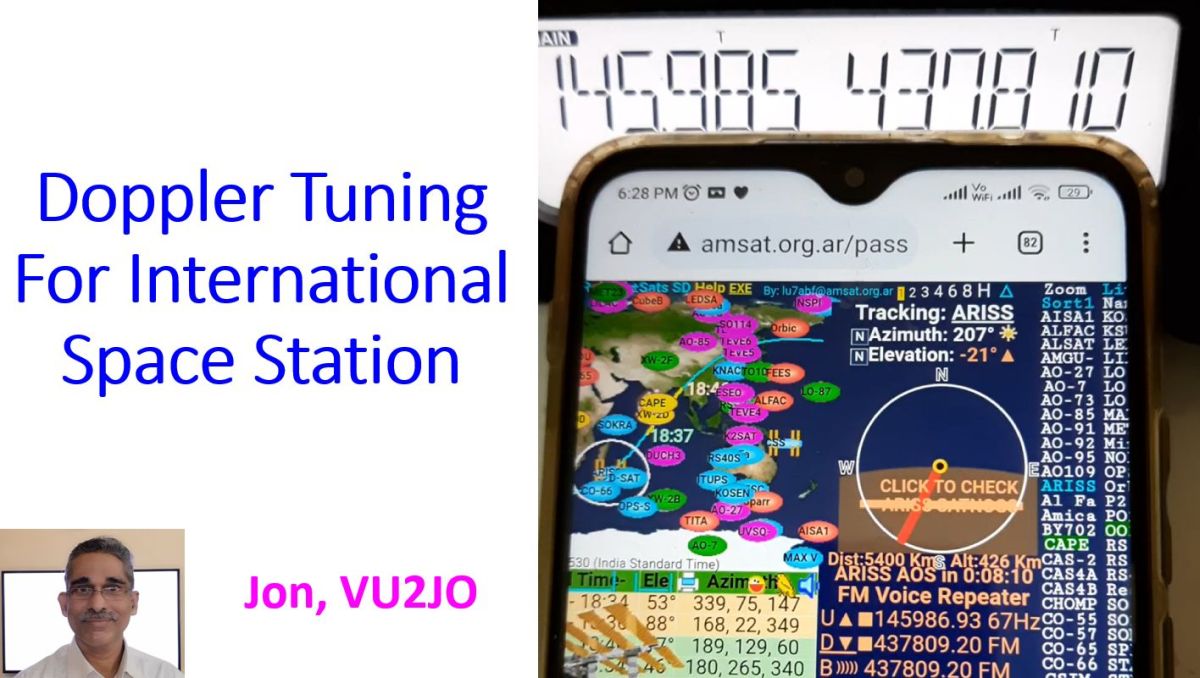Doppler Tuning For International Space Station
Doppler Tuning For International Space Station
Transcript of the video: This is a demonstration of Doppler tuning while trying to access voice transponder of International Space Station. The Argentinian Amsat website has been focussed here and you can see the frequencies being set. The uplink frequency shown here before the arrival of the satellite is 145.986 and a tone of 67 Hz is required. CTCSS tone. So the uplink frequency has been kept at 145.985 which is the nearest step which I have in my radio. The downlink is shown as 437.809 MHz, and I have set it as 437.810, which is the nearest step which I have in my radio. As soon as the satellite is in range, you can see that the colour of the frequency display changes to white, and colour of the compass needle also changes and a blinking display of the ARISS appears. Elevation, azimuth are all shown. Distance of the satellite from you, altitude of the satellite, everything is shown in the centre of the screen and frequencies have not changed much, because satellite is now only about 1 degree above.
The squelch has been kept fully open, in the downlink VFO, and you can see that the frequency display is slightly changing, in the website. That is uplink frequency is gradually going up, and downlink frequency is gradually coming down. We will wait till our frequency which is there in the radio is 2.5 kHz off frequency. When it is 2.5 kHz off frequency, I will change to the next step in each of the VFOs, because, the minimum step in my VFO is only 5 kHz. If you have a lower step, you can change earlier, but it will be more difficult as well.

You can see that I am changing the uplink frequency by 5 kHz when the frequency displayed in the website has gone 2.5 kHz above the step, and then, after some time, I am reducing the downlink frequency also in a similar way. You can also note that the elevation displayed is changing gradually, and the compass needle is also changing direction, tracking the movement of satellite.
[Audio recording of the contact between two stations] When the open squelch closes suddenly, you know that the radio is receiving the satellite signals, then you can hear the QSO going on between two stations, and you will adjust the Doppler accordingly sometimes, during QSO also, so that you can hear the QSO better. It may not be absolutely coinciding with what is shown in the display at the website. You may have to make your own adjustment also, because, what I have found is that it does not always exactly coincide with the Doppler display on the website. Sometimes it is slightly up or slightly low, or it could be because my tuning step is 5 kHz.
This is not a very good pass of the International Space Station in my region. Some passes I hear much better than this and remember that I am using only a vertical omnidirectional antenna. If you use a directional antenna, pointed in the direction of Space Station movement, along with tracking of azimuth and elevation simultaneously, as well as a computerized Doppler tracking, you will be certainly hearing the signals much better than this. This is from my very limited setup, which I am demonstrating.